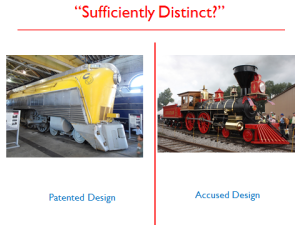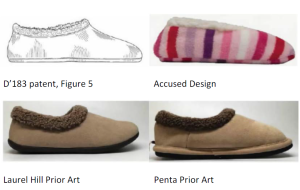by Perry Saidman
The Federal Circuit slipped in its recent opinion in High Point Design v. Meijer et al. involving a design patent on the now infamous “fuzzy slippers”. Although the opinion was non-precedential (2015 WL 4604995), it is worth reviewing since it is the second appeal in this case (“High Point II“), the first being a precedential opinion from September, 2013 (“High Point I“).
In High Point I, the Court took a giant step forward in clarifying its illogical pronouncements from International Seaway regarding design patent obviousness by confirming that it’s the viewpoint of a designer of ordinary skill, rather than an ordinary observer, that controls. It also did a great job regarding design parent functionality (see our earlier article “HIGH POINT FOR DESIGN PATENTS“).
In High Point II, decided July 30, 2015, the Court unfortunately slipped backwards in its analysis of the tricky area of design patent anticipation, and the not-so-tricky area of design patent infringement.
I. ANTICIPATION
Regarding anticipation, the Court repeated the shibboleth from International Seaway that design patent anticipation is analyzed from the perspective of an ordinary observer, using the infringement test from Gorham v. White – i.e., whether two designs are substantially the same in the eye of an ordinary observer.
In High Point II the Court stated:
Design patent anticipation requires a showing that a single prior art reference is “identical in all material respects” to the claimed invention. (citing Hupp v. Siroflex, 122 F.3d 1456, 1461 (Fed. Cir. 1997)). In other words, the two designs must be substantially the same. (citing Door-Master v. Yorktowne, 256 F.3d 1308 (Fed. Cir. 2001)).
The Court thus conflated the “identical” test from Hupp with the “ordinary observer” test from Door-Master. This makes no sense, since “identical” is not the same as “substantially the same”. If the terms were interchangeable and identical was the standard for anticipation, then infringement would require the accused design to be identical to the patented design, which would reverse Gorham v. White.
Hupp’s “identical” standard makes much more sense than “substantially the same” especially in comparison to the corresponding standard for utility patents where anticipation requires a single reference to teach each and every element of the claimed invention. If as little as one element is not identically taught, you’re into obviousness rather than anticipation. This is so elemental as to require no citation to authority.
The “ordinary observer” test considerably loosens the standard for finding design patent anticipation, and makes such rejections more difficult to traverse. Clearly, an ordinary observer would find more designs to be substantially the same than identical. Why should it be easier for a reference to anticipate a design patent claim than for it to anticipate a utility patent claim? The ordinary observer test is so subjective that USPTO design patent examiners are today relying more on anticipation rejections based on a single reference than obviousness rejections.
This is backwards.
In utility patent practice, it is more difficult for an examiner to sustain an anticipation rejection than an obviousness rejection, and thus examiners standardly back up a 102 rejection with a 103 rejection. This is especially true given that applicants can usually easily circumvent an anticipation rejection, by redefining an element, or adding a new element. This doesn’t always work to circumvent an obviousness rejection. In design patent practice, why should an examiner back up a subjective 102 anticipation rejection with a 103 obviousness rejection that is more difficult to sustain?
In seeming contradiction, the use of the “substantially the same” standard for anticipation conflates it with the standard for obviousness. The latter first requires identification of a primary reference, something in existence, which is “basically the same” as the claimed design.
When assessing the potential obviousness of a design, one must first find a single primary reference, a something in existence, the design characteristics of which are basically the same as the claimed design. In re Rosen 673 F.2d 388, 390 (CCPA 1982) (emphasis added). Without a primary reference, it is improper to reject a claimed design on grounds of obviousness. Durling v. Spectrum Furniture Co., 101 F.3d 100, 103 (Fed. Cir. 1996).
One might well ask, what’s the difference between the “substantially the same” standard for anticipation and the “basically the same” standard for a primary reference for obviousness? As a practical matter, there is no difference. Some of you might say that if anticipation is judged through the eye of the ordinary observer, and obviousness through the eye of a designer of ordinary skill in the art, there is a difference. The reality, of course, is that both eyes are the same: those of the finder of fact, who is the judge on summary judgment in 95% of design patent cases. So, the only difference is semantic and legally interesting, but not significant in the real world. Of course, you cannot parade ordinary observers to the witness stand, but you can parade a designer of ordinary skill, or more particularly an expert designer who can testify as to what a designer of ordinary skill would think. Such evidence can be lost in the shuffle, or easily countered by an opposing expert.
How did it come to pass that “identical in all material respects” was transformed into “substantially the same”? In short, it was incorrect legal analysis that goes all the way back to an 1889 Supreme Court case, Peters v. Active Mfg. Co., which famously stated: “[t]hat which infringes, if later would anticipate, if earlier.” (129 U.S. 530, 537 (1889)). This is one of those “maxims” of patent law that has been handed down from generation to generation as if it were the gospel.
This author has thoroughly analyzed why that “maxim” does not, and should not, apply to design patents in a note published 4 years ago in PTCJ, which apparently has not taken hold. Those of you interested in reversing the popularity of 102 rejections in design patent cases might find that analysis helpful.
On another note, the Federal Circuit in High Point II strangely cited design patent obviousness case law to support its conclusion that the claimed design was not anticipated by the prior art.
More particularly, the Court in High Point II cited its precedent from High Point I and Durling to support its anticipation analysis, when neither of those cases had anything to do with anticipation. The portions relied upon from those cases were about providing a sufficient verbal description of the claimed design before analyzing obviousness.
If the Court is correct in High Point II requiring a detailed verbal description of the claimed design when analyzing anticipation, then the Court must inevitably address the stark contradiction in claim construction requirements on the infringement and validity side. First, the Court equates the analysis for anticipation to the analysis for infringement. Then, in requiring a verbal description of a claimed design in analyzing anticipation, the Court flatly contradicts its holding in Egyptian Goddess that specifically did not require a detailed verbal description before analyzing infringement. In this author’s view, there is no reason for requiring a verbal description on the validity side and not on the infringement side, or stated another way, the illustrations of the design in the drawing figures are its own best description for both validity and infringement. Perhaps someday the Court will agree.
II. INFRINGEMENT
The Court again dipped into the subjective arena of design patent infringement analysis by agreeing with the district court that the patented and accused designs are “sufficiently distinct” such that the prior art need not be considered. This author suggests that rare is the case where two designs should be adjudicated “sufficiently distinct” to warrant ignoring the prior art.
Perhaps the following two designs are sufficiently distinct.
Since the abolition of the point of novelty test in Egyptian Goddess, the only objectivity available in the test for infringement involves a comparison of the claimed design, accused design and prior art. Is the claimed or accused design visually closer to the prior art than to each other? Then infringement is less likely. On the other hand, if the claimed and accused designs are visually closer to each other than either is to the prior art, infringement is more likely. Why would a fact-finder want to ignore the prior art, except perhaps when comparing an art deco locomotive with a steam locomotive? The prior art puts the patented and accused designs in some context.
For example, let’s look at the designs and prior art at issue in this (very) fuzzy slipper case:
It can be argued that the ‘183 patented design has a front slope that is more similar to the Laurel Hill prior art. On the other hand, the density of the fur of the patented design looks more like that of the accused design. And it is a fair conclusion that the accused design doesn’t much look like the prior art at all. A reasonable jury, presented with the accused design, the patented design, and the prior art, could conclude either infringement or non-infringement, depending on how they viewed the overall designs. But, the district court should not pre-empt the jury’s consideration of the evidence by simply concluding the patented and accused designs are “sufficiently distinct”. That would simply be a highly subjective (and lazy) way out.


